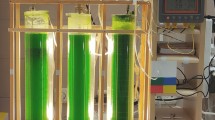Abstract
The aim of this work was to investigate the effect of different feeding times (2, 4, and 6 h) and organic loading rates (3, 6 and 12 gCOD l−1 day−1) on the performance of an anaerobic sequencing batch reactor containing immobilized biomass, as well as to verify the minimum amount of alkalinity that can be added to the influent. The reactor, in which mixing was achieved by recirculation of the liquid phase, was maintained at 30 ± 1°C, possessed 2.5 l reactional volume and treated 1.5 l cheese whey in 8-h cycles. Results showed that the effect of feeding time on reactor performance was more pronounced at higher values of organic loading rates (OLR). During operation at an OLR of 3 gCOD l−1 day−1, change in feeding time did not affect efficiency of organic matter removal from the reactor. At an OLR of 6 gCOD l−1 day−1, reactor efficiency improved in relation to the lower loading rate and tended to drop at longer feeding times. At an OLR of 12 gCOD l−1 day−1 the reactor showed to depend more on feeding time; higher feeding times resulted in a decrease in reactor efficiency. Under all conditions shock loads of 24 gCOD l−1 day−1 caused an increase in acids concentration in the effluent. However, despite this increase, the reactor regained stability readily and alkalinity supplied to the influent showed to be sufficient to maintain pH close to neutral during operation. Regardless of applied OLR, operation with feeding time of 2 h was which provided improved stability and rendered the process less susceptible to shock loads.














Similar content being viewed by others
References
Malaspina, F., Stante, L., Cellamare, C. M., & Tilche, A. (1995). Cheese whey and cheese factory wastewater treatment with a biological anaerobic–aerobic process. Water Science and Technology, 32, 59–72. doi:10.1016/0273-1223(96)00139-4.
Yan, J. Q., Lo, K. V., & Pinder, K. L. (1992). Instability caused by high strength of cheese whey in a UASB reactor. Biotechnology and Bioengineering, 41, 700–706. doi:10.1002/bit.260410704.
Borja, R., & Banks, C. J. (1995). Response of an anaerobic fluidized bed reactor treating and pH shocks. Journal of Biotechnology, 39, 251–259. doi:10.1016/0168-1656(95)00021-H.
Bermúdez, J. J., Jimeno, A., Cánovas-Díaz, M., Manjón, A., & Iborra, J. L. (1988). Stability of an anaerobic percolating filter during successive feed changes, and organic and hydraulic overloadings. Process Biochemistry, 23, 178–181.
García, P. A., Rico, J. L., & Fdz-Polanco, F. (1991). Anaerobic treatment of cheese whey in a two-phase UASB reactor. Environmental Technology, 12, 355–362.
Yilmazer, G., & Yenigün, O. (1999). Two-phase anaerobic treatment of cheese whey. Water Science and Technology, 40, 289–295. doi:10.1016/S0273-1223(99)00397-2.
Bagley, D. M., & Brodkorb, T. S. (1999). Modeling microbial kinetic in an anaerobic sequencing batch reactor—model development and experimental validation. Water Environment Research, 71, 1320–1332. doi:10.2175/106143096X122366.
Zaiat, M., Rodrigues, J. A. D., Ratusznei, S. M., Camargo, E. F. M., & Borzani, W. (2001). Anaerobic sequencing batch reactors for wastewater treatment: a developing technology. Applied Microbiology and Biotechnology, 55, 29–35. doi:10.1007/s002530000475.
Shizas, I., & Bagley, D. M. (2002). Improving anaerobic sequencing batch reactor performance by modifying operational parameters. Water Research, 36, 363–367. doi:10.1016/S0043-1354(01)00237-8.
Ramos, A. C. T., Ratusznei, S. M., Rodrigues, J. A. D., & Zaiat, M. (2003). Mass transfer improvement of a fixed-bed anaerobic sequencing batch reactor with liquid phase circulation. Journal of Science and Technology of the Americas—Interciencia, 28, 214–219.
APHA. (1995). Standard Methods for Examination of Water and Wastewater (19th ed.). Washington, DC, USA: American Public Health Association.
Acknowledgments
This study was supported by the Fundação de Amparo à Pesquisa of the Estado de São Paulo—FAPESP (São Paulo, Brasil), process number 03/09216-4. We also acknowledge the assistance of Dr. Baltus C. Bonse in the revision of this paper.
Author information
Authors and Affiliations
Corresponding author
Rights and permissions
About this article
Cite this article
Bezerra Jr., R.A., Rodrigues, J.A.D., Ratusznei, S.M. et al. Effects of Feed Time, Organic Loading and Shock Loads in Anaerobic Whey Treatment by an AnSBBR with Circulation. Appl Biochem Biotechnol 157, 140–158 (2009). https://doi.org/10.1007/s12010-008-8371-4
Received:
Accepted:
Published:
Issue Date:
DOI: https://doi.org/10.1007/s12010-008-8371-4




